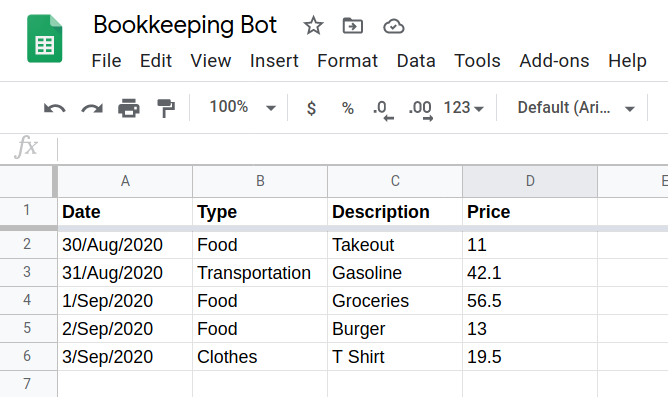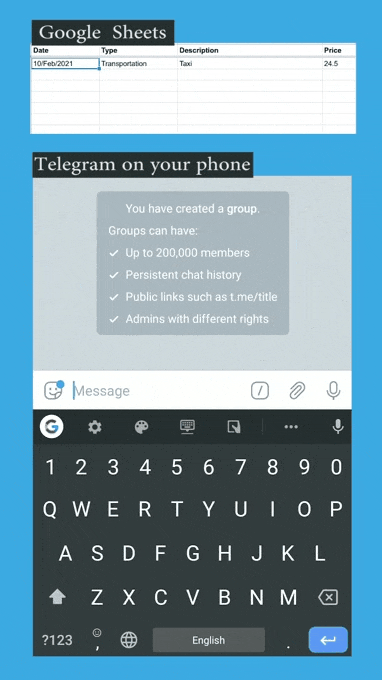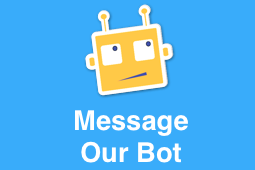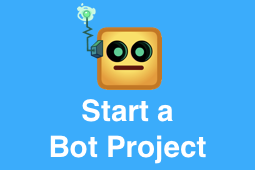 |
submitted by /u/softcompanyuk [link] [comments] |
Blog
-
Build A Bot: Purchase Requisition Bot using Microsoft Power Virtual Agent | Ai Chatbot
-
Alexa Moves Most Operations to Amazon-Built Chips
Alexa is moving the majority of its activities onto the Inferentia CPU delivered by Amazon. The movement away from the Nvidia chips…
-
My unusual friendship with Replica.
A tale of my love-hate relationship with Sussie, my Replica. A band-aid or a valuable tool?
-
Your own Bookkeeping Telegram Bot with Python

Photo by Jem Sahagun on Unsplash “Be careful with your money!”, my mother used to yell at me with a lovely tone, when I ran out of money before my next allowance. “Do you even know on what you have spent it? You should really keep track of your spending!”
And it is a wise piece of advice, right? I bet a good majority of us, responsible millennials attempting to do some proper adulting, sincerely try to do so. Yet there are only a handful of activities that I consider more tedious than writing down every expense I make. I mean it. I don’t think anyone reading this will happily turn down a couple of hours of Netflix to do some exciting accounting instead.
The good news is, my virtual pals, that we live in a world where technology offers the widest variety of possibilities! From filters that transform your face into a cute puppy, to the chance to program your very own minions and make your life easier. Your very own bot fleet! What if you could send a two word message to your digital servant and they would write it down in that dreadful spreadsheet for you?
With this in mind, I programmed a Telegram bot that takes care of this unpleasant but necessary activity for me, and it was far simpler than I had thought. You only need some basic understanding of Python to get your own bot running and accounting. Let me show you how easy it is!
Building your Bookkeeping Bot, step by step
Photo by Eric Tompkins on Unsplash Step 0: Create your Google sheet
I will be using Google Drive to store the spreadsheet. I chose to do that because it allows me to access it from anywhere if I need to. It also keeps your data safe and you do not have to worry about having local files. Therefore, you will need a Google account. If you don’t have that already, you will have to create one.
Step 1: Set up Google API access
In order to connect the Python script to your Google account, you will need to enable the Google Drive/Sheets API. This video in YouTube from Tech With Tim explains the process perfectly, which in summary is:
- Create a spreadsheet and fill in some cells, we will use that for testing. Give it a proper name.
- Go to Google Cloud Console and create a new project.
- Enable Google Drive API, setting web server access, to read application data, with Project>Editor role. Make sure to download your credentials in JSON format and store it in your project folder (keep it safe!).
- Enable Google Sheets API.

Step 2: Install libraries and test Google sheet access
Now, to make sure the script and your sheet are playing nice, we can do some testing in Python. The first thing you will need to do is install some libraries to interact with you freshly created spreadsheet:
pip install gspread
pip install gspread-dataframe
pip install oauth2clientNow you can already try things like downloading data from your sheet, edit the data, and upload again to update the sheet:
Now you want to put some data in your sheet to test it out:

And then go to your creds.json file, and look for the “client_email”. That is your assigned address in Google Drive API. Share the sheet you created with that email:

Now, you can initialize your client in Python and connect to the sheet:
We are getting the data into a dataframe, since this will help later when we start manipulating rows. The dataframe will look like this:
Date Type Description Price
0 30/Aug/2020 Food Takeout 11.0
1 31/Aug/2020 Transportation Gasoline 42.1
2 1/Sep/2020 Food Groceries 56.5
3 2/Sep/2020 Food Burger 13.0
4 3/Sep/2020 Clothes T Shirt 19.5
5 NaN NaN NaN NaN
6 NaN NaN NaN NaN
7 NaN NaN NaN NaN
8 NaN NaN NaN NaN
.. ... ... ... ...Now all these columns get imported as strings (dtype: object), so let’s give them the right format:
At this point you can get summaries for your data however you like. I am not going to get into that here, but just to give an example, you could aggregate using pivots and produce things like this:
Type Clothes Food Transportation
Date
2020-08 NaN 11.0 42.1
2020-09 19.5 69.5 NaNTrending Bot Articles:
4. How intelligent and automated conversational systems are driving B2C revenue and growth.
Step 3: Create a Telegram Bot
Now it’s time to create your Telegram bot, and a channel where you will send your expenses. To create a bot, you will need to write to Telegram’s BotFather, send the command /start, and follow the instructions to create your bot. You will receive a TOKEN, save it securely!
After creating it, send the command /setprivacy, choose your new bot, and then Disable. This allows your bot to read all messages coming to the channel, instead of just the ones beginning with a “/” (called “commands”).
Now create a Telegram channel, and add your bot’s username.
Step 4: Write your script
We can start now to write the python script that will handle all our expenses. You can begin with the following steps:
- Import all the libraries you will be needing
- Define variables
- Open a connection with your expenses sheet
- Get the data into a formatted dataframe
Next to the functions. We want a simple workflow:
- We input an expense description and its price, separated with a comma.
- The bot asks what type does the expense belong to, offering a predefined set of possible types as buttons.
- We select the type by pressing the button, and the bot saves the expense as a new row in the sheet.
For this we will create 2 methods, one that handles incoming messages and offers “types” of expense to choose from (“input_expense”), and the other that saves the expense in the sheet once we push a button (“callback_query_handler”, you must respect this name):
Finally, create the bot object, add handlers, and start polling:
Step 5: Test your Bot!
By now you should be able to send expenses to the channel (remember to send it in the form: description, price), and the bot will save your expenses in the sheet:

Conclusion
As you can see, getting your own app to handle daily expenses using Telegram and Google Sheets is really easy.
But this is just the beginning. You can use this as a starting point and take your expense tracking to a whole new level! For example, you could add commands to get monthly spending reports per spending type, or to search for expenses by text… You are only limited by your imagination here!
Now, we can both finally tell our parents that we learned how to be careful with our money!
Don’t forget to give us your 👏 !



Your own Bookkeeping Telegram Bot with Python was originally published in Chatbots Life on Medium, where people are continuing the conversation by highlighting and responding to this story.
-
How to improve the dropping customer satisfaction of the ChatBot

The customer satisfaction (CSAT) score of the Chatbot is beneficial in this digitalized age where you want to increase sales, reduce handling time and enhance the customer experience.
The very first step of any problem solving is to understand the probable pain areas of the customer.
Choose your method to analyze the situation
A. Root Cause analysis
B. SWOT

The method can be different, what matters is the exhaustive identification of the reasons which are affecting the performance of the chatbot
I like to use the Root cause analysis method as it helps to bifurcate the reasons the inputs received from various teams. Chatbot creation is not an individuals task, it’s a team effort to bring in the best understanding of the customer journey and integrating it through the chatbot.
Primarily the reasons can be
1. Technical
2. Communication
3. Response Time
Collect the data at each level and disseminate the information to the respective stakeholders of the various teams involved.

Trending Bot Articles:
4. How intelligent and automated conversational systems are driving B2C revenue and growth.
On primary analysis the major reasons could be.
Technical gaps could be
1. The chatbot is slow
2. Chatbot is not opening
3. Not able to redirect it properly to the support team
Communications gaps
1. Less information fed in for the customer to get redirected to the right support expert
2. Interaction points are exhaustive — Customized response based on the set of customer queries
Response/Support gaps
1. The support team is empathetic to the customer
2. Average Handling time(AHT) duration needs to be reduced to reduce customer fatigue
These are the broad categories of errors that might occur with your chatbot which in turn is dropping your customer satisfaction of your chatbot and addressing them in tandem can increase the CSAT gradually.
P.S. Below is the link to a video of a conversational chatbot created by me for a real estate platform a couple of years ago.
Don’t forget to give us your 👏 !



How to improve the dropping customer satisfaction of the ChatBot was originally published in Chatbots Life on Medium, where people are continuing the conversation by highlighting and responding to this story.
-
How to evaluate Chatbot output.
I have developed a GPT-2 based chatbot in German language. I am wondering if there is any metric other then perplexity. to measure the output quality. Would be nice if you can provide me a GitHub link or example.
submitted by /u/Old-Responsibility61
[link] [comments] -
How To Automate Asset Management With A Chatbot?
Communication and interaction between businesses and their customers underwent a sea change with the advent of Chatbots. Conventional methods of calls, emails, messages are not obsolete yet. But chatbots have substituted them to a great extent.
IT and ITES require recurrent customer support with real-time conversation. Using AI-enabled automation, that job is now easy. In the digital IT environment, all stakeholders look for real-time, engaging communication to solve problems. It is a great experience to get instant remedies and answers from bots rather than logging a service request and waiting for hours.
Chatbot Overview
An intelligent application, a chatbot built on AI, interacts with users, just as humans do. AI, Machine Learning (ML), and Natural Language Processing (NLP) are combined to build a chatbot application. In the IT industry, chatbots are introduced to make everyday jobs simpler, easier, and more efficient.

Automating Workflows
Raising change requests and modifying approvals are common tasks in an IT desk job. What normally happens is that people raise tickets when they want to query information about their assets. These tickets enter a cyclic process of approval and rejections until they resolve. Eventually, the process takes a long time and gets further delayed due to humans’ mistakes.On the other hand, Chatbots are programmed to complete these commands and tasks in a sequential order keeping people out of the workflow. What would take several minutes or hours by conventional means to get done in a jiffy with the help of chatbots? Simply, chat with your enterprise chatbot application, learn about your asset access, apply or revoke asset access, incorporate details, sync them with your assets, and find a lot more information.
HRs and admins can use chatbots to notify employees about their assets’ status. Chatbots have organized how asset management took place, giving HRs and administrators more space to catch up with other work. The development of Chatbot using NLP and ML has improved to such an extent that onboarding and offboarding employees can be done through automated chatbots by allocating just by talking with them. Once chatbots receive the requisite instructions, they produce the expected resources.
Powers Of A Chatbot
Developers are making these chatbots intelligent through successive updates. Improved algorithms, ML, AI, automation, and the implementation of IoT in Chatbots empower them to understand the nature of the request, requester project title, functional area or department, job role, employee number, etc. The need to use a separate application or browse through extensive spreadsheets to find information is diminished as AI-powered chatbots can display the requested information in seconds. A convenient tool for asset management in any IT or ITES organization, these bots can approve the corresponding management to grant access and even automate de-provisioning of access for users.
IT industry stakeholders benefit largely from Chatbots as it helps industry employees, end-users, and agents answer their requests. Volumes of paperwork got replaced with digital tickets in enterprise portals. Now, these are all handled by a smart chatbot.
Chatbots can also perform certain jobs. An exciting instance supporting this finding is that employees can prepare a helpdesk ticket volume report through chatbots. Once the chatbot is programmed with instructions to perform this task, all that needs to be done is to tell the chatbot when to trigger the process. The Chatbot prepares the report and delivers it to the agent instantly, needing no other employees’ intervention.
Trending Bot Articles:
4. How intelligent and automated conversational systems are driving B2C revenue and growth.
Bots are becoming more advanced with time. They are proactive in notifying agents about any significant event. They also act as messengers who can broadcast messages about asset allocation quite efficiently within an organization.
Usefulness of Chatbots
If asset management is difficult and eats out your precious time, here is how chatbots can help you. This complicated and labor-intensive job took a step up when AI chatbots started doing what humans could do.
Automating asset management or any other IT process that now uses chatbots has received the following benefits.
- Quick gateway to lots of information — Before employees get allocated to projects, they need to educate themselves about the project’s prerequisites. In large-scale organizations, employees find it challenging to procure assets and update the system. AI chatbots rescue this struggle by giving the employee directions to get the right info. Navigate documentation, locate your processes, make changes, query information, and do much more without waiting with chatbots. Internal documentation or knowledge base, a chatbot can help them find answers quickly.
- Chatbots aiding project support — One can discover how to send notifications regarding asset management using chatbots. This automates the otherwise tedious task of sending out alerts to users. For instance, a chatbot can send notifications for multiple tasks, set reminders to follow up with asset allocation, etc.
- The HR companion — For most organizations, a bulk of work rests on the HR’s shoulders. These include informing people of the company regulations, protocols, asset management, etc. Chatbots offer their friendly services to HR. They help employees register themselves with an asset, track asset allocation, asset movement, and asset validity just by asking a few questions in an application.
Conclusion
Thus we can say that the generation of technically inclined people is blessed with the advent of chatbots. One thing can be said for certain that it is not just for customers; it also helps employees conduct their job smoothly.
Don’t forget to give us your 👏 !



How To Automate Asset Management With A Chatbot? was originally published in Chatbots Life on Medium, where people are continuing the conversation by highlighting and responding to this story.
-
Best Ways of Making Money with Alexa Skills

The effectiveness of Alexa–Amazon’s digital assistant–depends on the skills Alexa has to offer. These Skills are mostly the third-party capabilities built by developers. The Alexa Skills count keeps rising every day, which nowadays has gone over 200 000 available ones worldwide.
The smart speaker market in the US is dominated by Amazon Alexa, accounting for more than 70% of all sales. This leads to promising long-term prospects for the device.
Recognizing these facts, have you ever considered making money with Alexa Skills?
This question goes not only for an Alexa Skill developer but also to businesses and Sellers.Of course, we can all agree that every new emerging technology has given ways to many companies to make a profit from them. In this case, Alexa Skills make no exception.

Some of the ways you can use in making money with Alexa Skills are:
- In-Skill Purchasing
- Alexa Developer Rewards
- Amazon Pay for Alexa Skills
- Alexa Prize
Surely, monetizing Alexa Skills won’t make you a millionaire within days or weeks but they can bring in a good income.
How to monetize Alexa Skills with In-Skill Purchasing?
If you ask how to monetize Alexa Skills with In-Skill Purchasing, there are two main ways.
The first is to offer Premium single-payment features or content, or by offering a monthly subscription for what your Skill and adding something extra for it to be worth the payment.
For example, if you build a game type of Skill, you can give the user the possibility to unlock extra levels in exchange for a single payment. Or, if you have made a Flash briefing Skill, you can give the user a subscription to premium or more personalized content for a monthly fee.
This can be one of the easiest ways of making money with Alexa Skills. However, your Skill should be already offering quality content with free use, for it to generate new users.
Trending Bot Articles:
4. How intelligent and automated conversational systems are driving B2C revenue and growth.
Earning money with Alexa Developer Rewards Program
To make customers happy, Amazon will award money to each Alexa Skill Developer that delivers exceptional customer engagement. Amazon Alexa Team considers the number of minutes used each month, total new customers, returning customers, ratings, sessions, and many other relevant factors.
Alexa Developer Rewards is currently available for skills offered in the U.S., U.K, and Germany, with more countries expected to be added soon.
A satisfying and useful experience will drive user behavior and bring customers back. Build something useful that users keep. Use these things to spread the word of your brand and make yourself part of the Alexa Developer Rewards program for the future months to come.
Monetize Alexa Skills with Amazon Pay
Amazon Pay enables Amazon account holders to use the payment methods already associated with their accounts. They can pay for goods or services comfortably, without having to enter their username, password, shipping address, or credit card details.
Amazon Pay for Alexa Skills is also a reliable money-maker. Amazon Pay became available for Alexa skills in 2018. Before that, the company did not allow third-party developers to sell physical products within Alexa skills.
Amazon Pay for Alexa Skills is also a reliable money-maker. Amazon Pay became available for Alexa skills in 2018. Before that, the company did not allow third-party developers to sell physical products within Alexa skills.
Sellers and Brands will be able to sell not only food, electronics, and clothing, but also event tickets, reservations, and much more.
Other means of making money with Alexa Skills
Amazon is expanding its voice assistant Alexa into millions of households and workplaces. Smart home devices such as Amazon Echo (or Amazon Echo Show or Amazon Echo Spot ) can be used to interact with compatible hardware and to access games, flash briefings, recipes, and other services.
This increasing interest in Alexa Skills has created many other opportunities to monetize them or the knowledge about their building process.
Amazon Alexa Prize
In November 2020, Amazon announced that the teams competing for the Alexa Prize Socialbot Grand Challenge 4 were selected. This prize is a multimillion-dollar university challenge that was initiated to advance human-computer interaction.
Specifically, these teams will create socialbots that can converse coherently and engagingly with humans on a range of different topics such as entertainment, sports, politics, technology, and fashion.
Each university team that participates will be awarded a $250,000 research grant. They will also receive Alexa-enabled devices and support from the Alexa team.
The grand challenge. One million dollars in research funding will be paid to the winning team’s university if their Socialbot has a composite score of at least 4.0. The Socialbot must be engaged with two-thirds of its human counterparts for at least twenty minutes.
Building Skills for others or training them
- Another way to make money by building Alexa skills is to build them for businesses or individuals. As more people purchase Alexa-enabled devices, we will need a wide variety of skills. Businesses, in particular, will want to invest in voice technology. Businesses will be looking for developers like you to create these skills and make their lives easier.
- Now that more and more developers are creating Alexa skills, training courses are an excellent resource for people who are looking to learn the complexities of this new voice-enabled world. You can sell these courses on your site as well. Just remember to create original, quality content that will be useful to users.
However, there are people who might want to build Alexa Skills and monetize them but don’t have coding experience. Or maybe have found the Alexa Skills Kit complicated.
In this case, you can use the Ipervox Platform, be it for a business, radio, or a podcast show. You can even create one if you are a blogger who wants to make his content part of the voice world.
All you need is to press “Get Started”, and you can start building your Alexa Skill with no difficulty whatsoever.Don’t forget to give us your 👏 !



Best Ways of Making Money with Alexa Skills was originally published in Chatbots Life on Medium, where people are continuing the conversation by highlighting and responding to this story.









